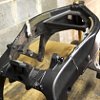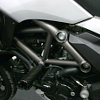Explaining the evolution of motorcycle frames without making folks glassy-eyed from boredom is not an easy task.
Things I'm avoiding: massively difficult engineering jargon and theory, as well as exotic and esoteric frame types. The chassis designs that have dominated the industry did so because they worked, and those are the ones I shall touch on.
Most folks know nothing about frames, which is a pity. So much R&D has gone into frames. Why are frames made the way they are? Why does a modern sportbike look so much different from the bikes of yesteryear?
A mixture of factors determines how a frame is designed: cost, intended usage, bike weight and performance level, “feel,” as well as material choice. All frames are a juggling act between these factors and usually quite a few more. Those characteristics are all closely related, so they all are taken into account when a chassis is being engineered.
Early motorcycle frames served chiefly as a mounting point for all the things that make a stack of tubing different from a motorcycle. As riders learned how much the frame contributed to the ride, handling, and performance of a motorbike, frame technology evolved right alongside other motorcycle components.
Motorcycle frames started looking markedly different from bicycle frames in the earliest part of the 20th century. Simply stated, engines, being more powerful than human legs, dictated a different design. Fast-forward to modern times. Bikes have both front and rear suspension. The frame serves to act as a link between these pieces as well as giving the bike its strength and structure. It’s generally agreed that the most responsive chassis designs incorporate a super-stiff section that runs from the headstock to swingarm pivot in as straight a line as possible to minimize extraneous deformation.


The step up from the single-cradle frame is the duplex frame. Some bright fella realized that if two single cradle frames were run in tandem with some reinforcement tying them together, the frame would be vastly less flexible. The most famous early duplex frame was probably the Norton Featherbed of the 1950s, but many notable examples have been produced since. Related to the duplex frame is the half-duplex, which is sort of a blend of single-cradle and double-cradle (duplex) frames: They typically exist as a duplex section beneath the engine, but often include a larger diameter single tube in the spine and for part of the frame’s downtubes. The most famous half-duplex frame is probably the Harley-Davidson four-speed frame.
As riders and powerplants began to test the bounds of duplex frames, engineers looked for ways to reduce chassis flex further. Enter the twin-spar frame, also known as a perimeter frame. A twin-spar frame moves the upper portion of the duplex rails outward, to the perimeter of the bike. By widening the upper portion of the frame, the entire frame becomes less compliant. The headstock and swingarm pivot area become even more resistant to heavy loads that can occur during cornering and braking. These frames are typically made stiffer still by their material choice: Most modern perimeter frames are made of boxed aluminum, making them visually quite large, but structurally very light and strong. A pretty famous perimeter frame would be Yamaha’s Deltabox series.

Related to the perimeter frame is the trellis setup. Trellis frames are really not very different from a twin-spar frame. You could think of them as a subset. Instead of using a large boxed section of material, trellis frames employ twin tubes that make their way from headstock to swingarm pivot. Those tubes get added stiffness and rigidity from shorter sections of tubing welded between them. (Well, most of them can be welded. Steel is the usual material used in trellis frames.) The end result looks like latticework, or a trellis, hence the name. The most notable trellis frames are probably those of Ducati, which have been a hallmark of the Monster line since its inception.

A less-than-common frame style is the pressed-steel frame and closely related monocoque chassis. Rather than using traditional frame building materials, such as boxed sections and tubing, pressed-steel frames boast formed sections made of light-gauge sheet steel that’s been formed and pressed in dies and then spot-welded. Frames made this way are usually light and easy to manufacture. They are particularly susceptible to impact and rust. A fairly famous pressed-steel-framed bike was the Honda Dream. Monocoque frames are similarly constructed, but incorporate the bike’s outer skin (bodywork) as a structural piece of the frame. Older Vespa scooters utilize this design.

The last item that relates to frames is actually the engine. At some point, an engineer realized that because engines are, structurally, just very rigid aluminum boxes, they could serve double duty by acting as a part of the frame. You may have seen engine and frame combos described as “stressed members.” (You might also have heard an old-timer define this type of frame as a “keystone” frame; their heyday was in the early part of the 20th century.) The stressed-member frame is usually characterized by an engine that appears to “hang,” with no visible means of support beneath the engine. The stressed-member design can be used with more than one style of frame, so you will often hear this incorporated into the description of the chassis. ("It's a stressed-member, dual-spar design.")

Frames are quite literally the support structure for your entire bike. Not only have frame designs evolved tremendously, but so have metallurgy and manufacturing processes. All that means that frames do a better job than ever of keeping our wheels pointed in the right direction, providing performance that would be other-worldly by the standards of old. And that’s why things are the way they are.































 Riders Preferred Membership
Riders Preferred Membership















